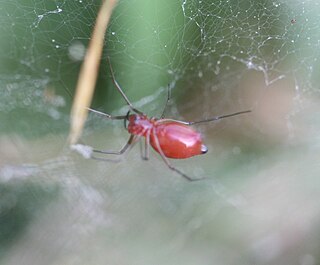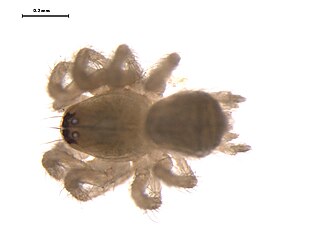
The bowl and doily spider is a species of sheet weaver found in North and Central America. It is a small spider, about 4 mm (0.16 in) long, that weaves a fairly complex and unique sheet web system consisting of an inverted dome shaped web, or "bowl," suspended above a horizontal sheet web, or "doily", hence its common name. The spider hangs from the underside of the "bowl", and bites through the web small flies, gnats and other small insects that fall down into the non-sticky webbing. The webs are commonly seen in weedy fields and in shrubs, and may often contain both a male and a female spider in late summer - like many linyphiids, Frontinella males and females may cohabitate for some time. Males exhibit competition for female mates both by fighting and sperm competition. Uniquely, these spiders exhibit behavioral thermoregulation and have lengthened circadian rhythms.

Florinda, commonly called black-tailed red sheetweaver or red grass spider, is a monotypic genus of dwarf spiders containing the single species, Florinda coccinea. It was first described by Octavius Pickard-Cambridge in 1896, and has only been found in Mexico, the West Indies, and the United States. It is common in the southeastern United States, inhabiting grasslands, lawns, and agricultural fields.

Pimoidae is a small family of araneomorph spiders first described by J. Wunderlich in 1986. It contains 37 species in four genera and is monophyletic. It is closely related to the Linyphiidae, and is sometimes treated as synonymous with that family.

Physocyclus is a genus of cellar spiders that was first described by Eugène Louis Simon in 1893.
Mallos is a genus of cribellate araneomorph spiders in the family Dictynidae, and was first described by O. Pickard-Cambridge in 1902. Among the genus, Mallos gregalis is known to be a social spider species, living in groups and signaling each other by vibrating their web.

Coneweb spiders (Diguetidae) are six-eyed haplogyne spiders that live in tangled space webs, fashioning a cone-like central retreat where they hide and lay eggs. It is a small family, containing only two genera with fifteen species and is confined to the New World, preferring deserts. Members of the genus Diguetia usually build their webs in shrubs or between cactus pads. They have the same eye arrangement as the venomous recluse spiders, but none are known to be harmful to humans.

Dictyna is a genus of cribellate araneomorph spiders in the family Dictynidae, and was first described by Carl Jakob Sundevall in 1833.

Frontinella is a genus of dwarf spiders that was first described by Frederick Octavius Pickard-Cambridge in 1902.
Phrurolithidae is a family of araneomorph spiders first described by N. Banks in 1982. First included in the Corinnidae as the subfamily Phrurolithinae, later phylogenetic studies justified a separate family.

Emblyna is a genus of cribellate araneomorph spiders in the family Dictynidae, and was first described by R. V. Chamberlin in 1948.

Lathys is a genus of cribellate araneomorph spiders in the family Dictynidae, and was first described by Eugène Simon in 1884. It is a replacement name for "Lethia" Menge, 1869 because that name was already in use as a synonym for a genus of moths.
Thallumetus is a genus of cribellate araneomorph spiders in the family Dictynidae, and was first described by Eugène Simon in 1893.

Neoantistea is a genus of dwarf sheet spiders that was first described by Willis J. Gertsch in 1934.
Jalapyphantes is a genus of dwarf spiders that was first described by Carl Eduard Adolph Gerstaecker & L. I. Davis in 1946.
Selenyphantes is a monotypic genus of sheet weavers containing the single species, Selenyphantes longispinosus. It was first described by Carl Eduard Adolph Gerstaecker & L. I. Davis in 1946, and has only been found in Guatemala and Mexico.

Hentziectypus is a genus of comb-footed spiders that was first described by Allan Frost Archer in 1946. Originally placed with Theridion, it was moved to Achaearanea in 1955, and to its own genus in 2008. These spiders most resemble members of Cryptachaea, but are distinguished by a median apophysis that is broadly attached to the tegulum. Spiders of Parasteatoda have a median apophysis attached to the embolus, while those of Achaearanea have a hooked paracymbium on the pedipalps of males.
Steatoda variata is a species of cobweb spider in the family Theridiidae. It is found in the United States and Mexico.

Phrurotimpus alarius is a species of true spider in the family Phrurolithidae. It is found in the United States and Canada.
Xenoctenidae is a family of araneomorph spiders separated from Miturgidae in 2017.
Phonotimpus is a genus of North American araneomorph spiders in the family Phrurolithidae. It was first described by Willis J. Gertsch and Louie Irby Davis in 1940, and placed with the Liocranidae. It was transferred to Corinnidae in 2002, then to the Phrurolithidae in 2014.










